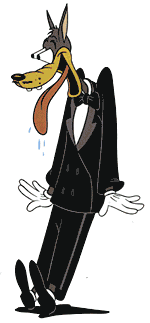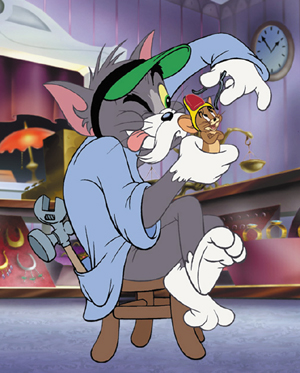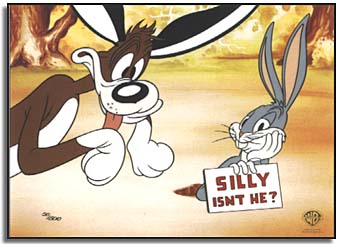Starting the Discussion
More From
Termite Terrace

Maltin,
pp. 281-309; Klein, pp. 146-161
Maltin:
- Why was MGM often called
"the Tiffany's of motion picture studios"? What shared goal of Hugh
Harman and Rudolf Ising did the studio promise to further when they set up
shop there? By the early 1950s, how long was the production time on the average
studio-produced cartoon short?
- What were the strengths
and weakness of Harmon-Ising productions during the 1930s?
- When MGM set up an internal
animation unit, they lured Friz Freleng from Warner Brothers (for a short
time). His comment on his stint at MGM was that "the budgets there were
much larger than the Warner's budget, but it didn't help the pictures any
because they had the wrong concepts to start with." What continuing creative
impasse at MGM was Freleng pointing to in this comment?
- In the later '30s, Ising
invented Barney Bear. Why didn't that series ever take off?
- What made the team of
Bill Hanna and Joe Barbera work from the moment they got together? How were
their backgrounds similar? What made them different?
- Your text gives you a
lengthy discussion of MGM's most popular cartoon characters through the 1940s
and early 1950s: Tom and Jerry. How did Hanna and Barbara come up with the
team? What were the consistent strengths of the Tom and Jerry cartoons? How
did their animators keep the formula from getting stale?

- Though he had a large
role in developing such Looney Tunes characters as Bugs Bunny and Porky
Pig, Tex Avery moved to MGM during the World War II years. What were Avery's
strengths as a director at MGM? How could his work be directly opposed to
the style favored by the Disney studio during the war years?
- The Wolf was a character
not much favored by the censors in the Hays Office; why not? Who did love
the Wolf cartoons and in fact adopt him and his co-star as mascots? When did
Avery first realize that the Wolf was a true success?
- How do the Wolf cartoons
compare with the earlier Betty Boop cartoons? What made their respective heroines
different? How were they similar?
- What other kinds of work
were typical of Avery's output at MGM? How would you characterize his style?
- Wheras Termite Terrace
at Warner Brother's was fairly isolated from the studio around it, the MGM
animation unit was much more a part of the studio as a whole. How did this
integration show itself in some of the MGM live action films of the mid-1940s?
- The largest such collaboration
was with Gene Kelly in Invitation to the Dance (1953). What was the
process by which the animators were able to pair Kelly up with a variety of
animated dancing partners in an extended sequence?
- Like Warner's, MGM greeted
the fall off of theatrical attendance of the 1950s by producing "cheater"
cartoons. What were "cheater" cartoons?
- What became of the various
animation personnel when they left MGM? Where did Hanna and Barbara in particular
find themselves?
- How about Tom and Jerry:
what was in their future in 1956?
- By the mid-1960s, Chuck
Jones had his own production company, but did several pieces for MGM; what
kind of work was he producing at that time?
 Klein:
Klein:
- In this section, we move
further into the stylistic qualities of full animation, as practiced by such
major studios as Disney and Warner Brothers. As you read, pay particular attention
to the connection between live action and animated films during this period.
- To what extent were special
effects of this period an outgrowth of animation technique? How did these
special effects progress into the CGI available to us today?
- Looking back at the lecture
last Thursday, what do we mean by "depth of field"? How was it being
used in live action films like Citizen Kane?
- What made full animation
at different studios and in different years so distinctive?
- How did the ability to manipulate individual layers or surfaces in full
animation free animators to be more creative?
- What was the cost of the increasing drive at the Disney studio to achieve
a full animation that mimicked the mise en scene and camera movement of live
action films? How did the cartoonists at Warner Brothers achieve full animation
differently?
- "At the heart of full animation is the conflict between self-control
and explosion," Klein observes. You should be ready to apply his observation
to the work of Freleng, Clampett, Jones and Avery.
- Why, by the way, was it impossible to move Mickey to full animation in the
way Donald was moved?
- How did anarchy survive in the animated short, even within the drive for
full animation? How important is this element of animation, present from the
very beginning of the art?
- In Chapter 14, Klein
provides an incredibly useful outline of the production line as it existed
(with suitable variation) at the major animation studios in 1940. You should
take this opportunity to review the increasingly complicated process of producing
an animated short--as well as the way in which it has become both a group
and an individual creation.
- As you review, you might
also note how much of this process has been packed into the version of Flash
you're using to create your own films.

In class, we'll be looking
at the following cartoons and clips:
- Swing Shift Cinderella
(1945)
- Lucky Ducky (1948)
- Anchors Aweigh
(1944) [excerpt of dance of Gene Kelly and Jerry the Mouse]
- Invitation to the
Dance (1953) [excerpt from "Sinbad the Sailor"]
Back
to Home Page



 Klein:
Klein: